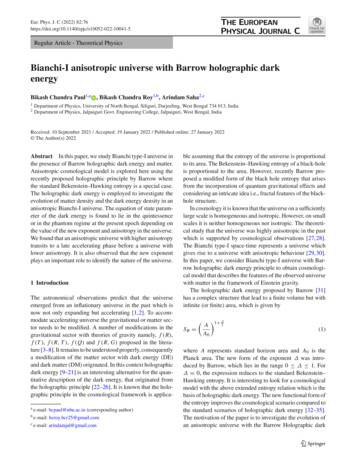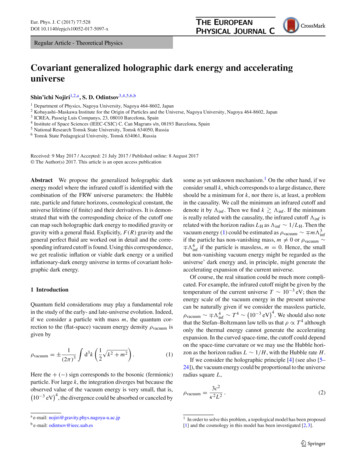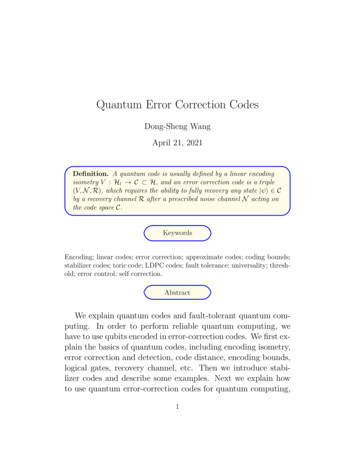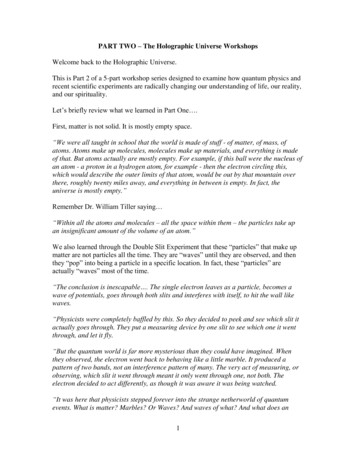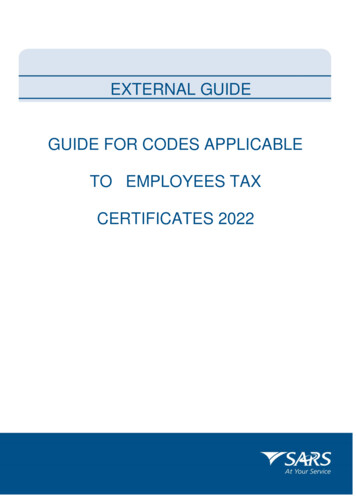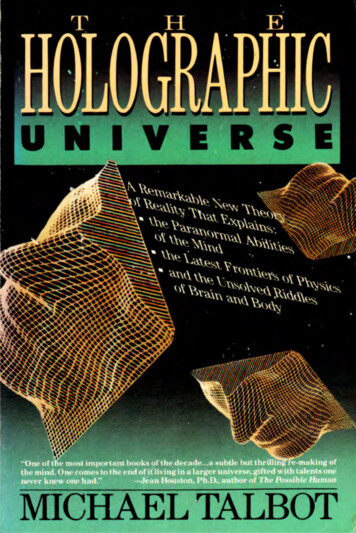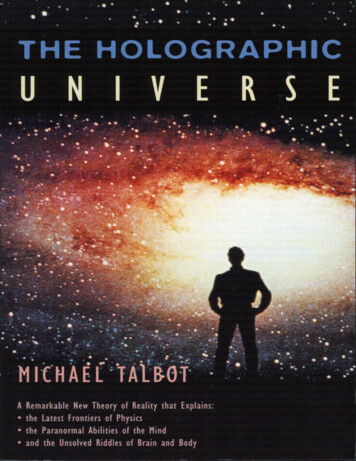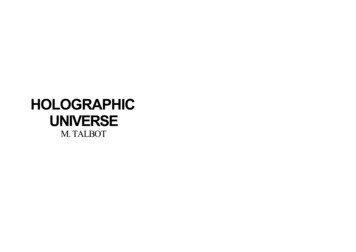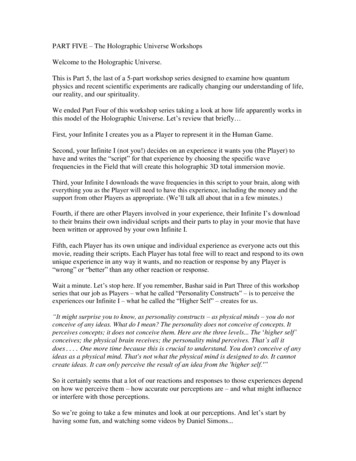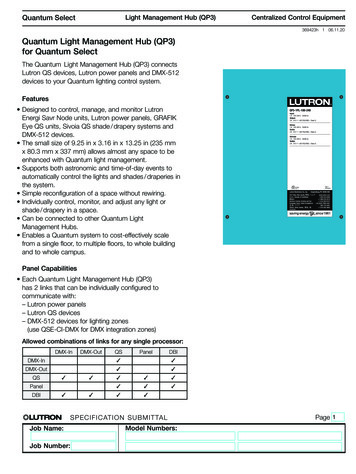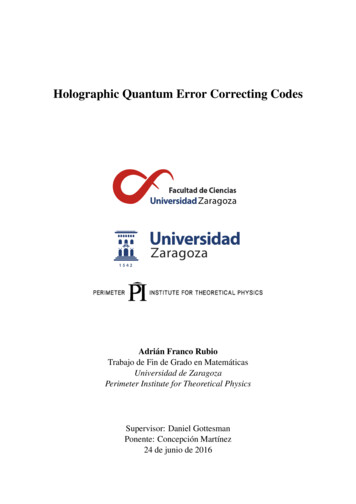
Transcription
Holographic Quantum Error Correcting CodesAdrián Franco RubioTrabajo de Fin de Grado en MatemáticasUniversidad de ZaragozaPerimeter Institute for Theoretical PhysicsSupervisor: Daniel GottesmanPonente: Concepción Martínez24 de junio de 2016
Acknowledgements / AgradecimientosI would like to thank from these lines everyone who has helped me directly and indirectly for the realization of this project. Many thanks to my supervisor, Dr. Daniel Gottesman, for agreeing to supervise aproject for a University thousands of kilometres away from Perimeter Institute, and for actively helpingme to carry out the project. Thanks as well to Dr. Beni Yoshida for his guidance and for quickly answering my questions even when he was away from the Perimeter. Many thanks to my fellow studentswho read the draft and made comments and corrections.Quisiera expresar mi gratitud igualmente a la Facultad de Ciencias de la Universidad de Zaragoza porponerlo todo a mi favor para que pudiera culminar mis estudios de grado a distancia, incluida la realización de este trabajo de fin de grado. En particular muchísimas gracias a la profesora ConcepciónMartínez por acceder a ejercer como mi ponente y por tomarse el máximo interés en que mi trabajosaliera adelante en los plazos previstos. Muchas gracias también a mis amigos de la Facultad, sin cuyaayuda las cosas habrían sido mucho más difíciles, y a mi familia, cuyo apoyo constante me ha impulsadodurante el curso, como lleva haciendo desde siempre.iii
ResumenA la hora de transmitir y procesar información hemos de tener en cuenta que la probabilidad de fallo denuestros sistemas en el mundo real es distinta de cero, y por tanto existe la posibilidad de que durantedichos procedimientos se introduzcan errores en la información tratada. Para intentar prevenir esteproblema se desarrollaron los códigos correctores de errores, cuya filosofía es relativamente sencilla: lainformación que se pretende proteger se codifica en un número de bits mayor que el mínimo necesario,de modo que la consiguiente redundancia permita recuperar la información incluso en el caso de quealgunos bits se vean sometidos a errores.Tras la aparición de la teoría cuántica a principios del siglo XX, numerosos esfuerzos se han dedicado a explotar los principios de la misma para obtener ventajas en el ámbito del procesado de información, dando lugar al nacimiento de la teoría de la información cuántica. Al contrario que en el casoclásico, en el que los bits, unidades mínimas de información, son variables reales que toman los valores0 y 1; en información cuántica se emplean los qubits o quantum bits, que son vectores en un espaciode Hilbert bidimensional, que no sólo permite los valores 0i y 1i, los cuales ahora forman una baseortonormal de dicho espacio, sino también combinaciones lineales α 0i β 1i de los mismos. Losaxiomas de la mecánica cuántica indican además que el estado de un conjunto de qubits es de nuevo unvector en el espacio producto tensorial de los espacios de Hilbert asociados a cada qubit.Los sistemas cuánticos son particularmente sensibles a interacciones con su entorno, lo que haceaún más relevante la corrección de errores en este caso. Un código corrector de errores cuántico esuna isometría entre espacios de Hilbert que codifican el estado de información de un cierto número dequbits en un número mayor de qubits. La imagen de esta isometría es el llamado subespacio de código,que es isomorfo al espacio de estados de los qubits codificados, y cuyas propiedades son de relevanciapara comprender cómo de útil es el código. Los códigos estabilizadores son una clase particular decódigos para los que dicho subespacio puede ser caracterizado mediante su estabilizador, un grupo deoperadores lineales que deja invariantes todos los elementos del subespacio. Conocer el estabilizadorde un código, y en particular un conjunto de generadores del mismo facilita significativamente partedel trabajo con el código. El código básico con el que se construyen todos los que vamos a tratar es elllamado five qubit code o código de cinco qubits, que codifica la información de un único qubit lógico(input) en cinco qubits físicos (output). Este código es capaz de preservar la información frente a ladesaparición o borrado de dos qubits cualesquiera de los cinco, y también es capaz de corregir un errorcualquiera en uno de los qubits sin necesidad de la información de cuál de ellos ha sido alterado.Además de su uso en el ámbito del procesado cuántico de información, los códigos cuánticos correctores de errores han sido objeto de mucha atención recientemente debido a una propuesta que losconectaría con el principio holográfico y la corerspondencia AdS/CFT, una dualidad existente entreteorías gravitatorias y teorías cuánticas de campos que se está estudiando con el objetivo de entendercómo llegar a una teoría de la gravitación cuántica. En 2015, un equipo de investigadores [1] introdujo los códigos cuánticos correctores de errores holográficos como modelo de juguete para explorarla relación entre corrección de errores y holografía. Estos códigos se definen por medio de un circuitocuántico, o red tensorial, que es una representación gráfica de las operaciones de codificación a las quese someten los qubits lógicos para obtener el resultado, los qubits físicos. En concreto, en los códigoscon los que trabajamos la geometría subyacente a este circuito es hiperbólica, y los construiremos apartir de una teselación del disco de Poincaré de símbolo de Schläffi (4,5) que truncaremos para que seafinita. Cada vértice de la red corresponderá a una operación de codificación como la del código de cincov
viChapter 0. Resumenqubits.El objetivo principal de este trabajo es el cómputo de los generadores del estabilizador de una familia particular de códigos correctores de errores cuánticos holográficos que llamamos, a falta de unanomenclatura más sistemática, códigos basados en las caras o FBC (face based codes), pues el procesode truncado de la teselación infinita para dar un circuito finito se realiza prestando atención a las caras dela misma. De esta manera obtenemos una familia de códigos indexada por los números naturales y construida añadiendo sucesivas capas (que incluyen nuevos qubits lógicos y físicos, y nuevas operacionesde codificación) a una red creciente. El método que empleamos está inspirado en [1] y [2] y consisteen construir el estabilizador el código “empujando” hacia la frontera del mismo los estabilizadores delos códigos más pequeños que lo componen. La última es por supuesto una frase muy poco técnica queserá reformulada de forma rigurosa en el texto principal del trabajo.Para determinar el estabilizador de los citados códigos comenzamos centrándonos en el primerode ellos. Con el método empleado podemos generar elementos del estabilizador de manera relativamente sencilla a partir de lo que llamamos construcciones de estabilizador. A partir de ellas obtenemosgeneradores muy localizados que son claramente independendientes pues actúan sobre qubits físicosdistintos. También encontramos otros generadores con soportes más amplios y probamos que son independientes entre sí y de los demás en una aplicación sencilla de la teoría de grupos. Puesto que sabemoscuál es el tamaño del estabilizador, encontrar suficientes generadores que se pueden hallar a partir deconstrucciones de estabilizador nos permite probar que podemos obtener todo el grupo de esta manera.Pasamos posteriormente a generalizar el procedimiento para cualquiera de estos códigos (cualquiernúmero de capas). Para ello combinamos las dos estrategias que empleamos en el caso de una solacapa. En primer lugar, construimos generadores muy localizados que sólo actúan sobre unos pocosqubits físicos. En segundo lugar aprovechamos la existencia de un homomorfismo entre el estabilizadorde un código y el del código con una capa menos para dar una construcción recursiva de los generadoresrestantes hasta cubrir el total necesario.El estudio del estabilizador de este tipo de códigos no sólo plantea las ventajas habituales en lacaracterización de los mismos como códigos correctores de errores, sino que abre la puerta a analizarfenómenos como la localización de los generadores del estabilizador (el hecho de que actúen de manerano trivial en sólo una fracción reducida de los qubits de la frontera), que podría proveernos de intuicióna la hora de entender la relación entre estos modelos de juguete y la correspondencia AdS/CFT. Por otraparte, quedan abiertos problemas como la determinación de las fault-tolerant gates o puertas lógicas aprueba de errores, como se denominan aquellas implementaciones a nivel de código de puertas lógicasque optimizan las propiedades de corrección de errores del mismo.
ContentsAcknowledgements / AgradecimientosiiiResumen12vQuantum Error Correction1.1 Basic definitions and notation . . . . . . . . .1.1.1 Quantum states . . . . . . . . . . . .1.1.2 Quantum operations . . . . . . . . .1.1.3 Quantum measurement . . . . . . . .1.1.4 Quantum circuits and tensor networks1.2 Quantum Error Correcting Codes . . . . . . .1.2.1 Error models . . . . . . . . . . . . .1.2.2 Encoded operations . . . . . . . . . .1.3 Stabilizer codes . . . . . . . . . . . . . . . .1.3.1 The five qubit code . . . . . . . . . .1.3.2 Quantum secret sharing . . . . . . . .11124568891113Holographic Quantum Error Correcting Codes2.1 Why HQECC? . . . . . . . . . . . . . . .2.2 Hyperbolic tilings . . . . . . . . . . . . . .2.3 A first HQECC . . . . . . . . . . . . . . .2.4 The network grows . . . . . . . . . . . . .2.5 The stabilizer of a general FBC . . . . . . .2.6 Conclusions and outlook . . . . . . . . . .15151617222425Bibliography.27vii
Chapter 1Quantum Error CorrectionIt is the aim of this chapter to introduce the formalism of quantum error correction that will be used in thesecond part of this work, where the original contributions will be presented. No knowledge of quantummechanics is assumed from the reader, and hence we will intend to keep everything self-contained. Mostof what is explained here can be found in references [3, 4, 5].1.11.1.1Basic definitions and notationQuantum statesIn quantum mechanics, one of the most fundamental objects we encounter is the state of a quantumsystem. Anything that behaves according to quantum mechanics (such as an electron or a photon, orany collection of them) will be a quantum system that will find itself in a particular state. This statecontains all the information about every degree of freedom of the system (such as the position of aparticle, or its magnetic moment) and belongs to a set of states that must have a particular structure:Definition 1.1. The space of states of a quantum system is a Hilbert space (H , h, i), whose elementsrepresent the possible physical states in which we can find the system. In particular, if the Hilbert spaceis two-dimensional, that is H C2 , the system will be called a two level system or a qubit.Throughout this thesis we will use the standard Dirac notation, in which vectors belonging to a spaceof states H are written in the so-called ket-form: ψi H . Their associated linear forms in the dual ofH will therefore assume the bra-form: hψ H , so that the inner product of vectors χi, ψi H isgiven by hχ ψi, that is the bra hχ acting on the ket ψi. Also, in this notation ψihχ is a linear operatoron H which will map a vector ξ i to the vector hχ ξ i ψi. In particular, this means that: ψihψ hψ ψiis a rank-one projector on the one-dimensional subspace generated by ψi.Depending on what system we are dealing with, the space of states will have different aspect. Forexample, if we consider a particle which can move in one dimension, its space of states is spanned bythe states { xi}x R , where x denotes the position of the particle. Clearly this is an infinite dimensionalHilbert space, and requires some knowledge of functional analysis to be dealt with rigorously. Butlet us go back to qubits. Any physical system that has two fundamentally different possible quantumstates, such as an electron’s intrinsic angular momentum or spin (which can point “up” or “down”),or a photon’s polarization axis (horizontal or vertical) realizes the abstract notion of a qubit. Qubitsplay in quantum information science the same role that bits do in classical information science as thefundamental units of information. Let H be the Hilbert space of a qubit, then we can choose a pair oforthonormal vectors that will constitute a basis of such space and that we will denote in a very suggestiveway:H span{ 0i, 1i}h0 1i 01
2Chapter 1. Quantum Error CorrectionIndeed, a qubit in the state 0i will be the analogue of a classical bit of value 0, while a qubit in the state 1i will be the analogue of the classical bit having value 1. This is called the computational basis Therules of quantum mechanics, nevertheless, allow for more general states of the form α 0i β 1i H ,for α, β C. These will in general not correspond to classical bit states, specifically when α, β 6 0, inwhich case we will say that our qubit is in a superposition. The following is also standard notation foranother orthonormal basis in H :1 i ( 0i 1i)21 i ( 0i 1i)2The fact that we are considering orthonormal bases goes a little bit further than just mere computational convenience: in quantum mechanics, states which are proportional to each other are considered tobe indistinguishable from a physical point of view. In more precise words, the space of different statesof a quantum system is the space of rays in the associated Hilbert space, i. e., the projective Hilbertspace PH . In general, to work in the quantum framework we normalize our states, that is, we use arepresentative of the equivalence class that has norm 1, and that is what we will assume in the rest of thiswork (otherwise whatever we computed with the theory, such as probabilities of different outcomes ofmeasurements, would need to be renormalized for them to be independent of the representative used).To be able to perform nontrivial quantum computations we should be able to deal with systemsbigger than just one qubit, in the same fashion that classical computers do not carry out calculationsusing just one bit. Quantum mechanics provides us with a rule of thumb (technically an axiom) as tohow to build the space of states of systems composed of smaller subsystems:Axiom 1.1. The space of states HAB of a system composed of subsystems A and B whose respectivespaces of states are HA and HB is the tensor product of these:H HA HBHence, the space of states of a set of n qubits (from now on we will use the notation Hn to refer tosuch Hilbert spaces) will be isomorphic ton2Hn . . C}2 (C2 ) n C2 C .{znAnd the computational basis will be given by the corresponding tensor product of the computationalbases of the individual qubits, as seen here for the case n 2: 0i 0i 0i 0i 00i 1i 0i 1i 0i 10i1.1.2 0i 1i 0i 1i 01i 1i 1i 1i 1i 11iQuantum operationsWhen it comes to the physical interpretation of quantum mechanics, the inner product structure of theHilbert space is of the utmost importance. Indeed, the axiom known as the Born rule, which we willintroduce below, produces probabilities for the result of a measurement in terms of the inner product.As a consequence, the allowed operations1 that we can perform on a quantum state are those whichpreserve this structure, usually called unitary operations:Definition 1.2. The unitary group U (H ) on the Hilbert space H is the set of linear operators definedon it U : H 7 H which preserve the inner product, that ishU χ Uψi hχ ψi ψi, χi H(1.1)1 To be fair, the most general quantum operation that is allowed by the rules of quantum mechanics is a completely positive,trace preserving linear map or CPTP map, but for the purpose of this essay we can safely restrict ourselves to unitary operations.
Holographic Quantum Error Correcting Codes - Adrián Franco Rubio3In the case of a qubit, the unitary group is the set of 2 2 complex unitary matrices:U (C2 ) U (2, C) {U M(2, C) U 1 U † }(1.2)Of this group we would like to single out a very particular discrete subgroup. Let us start by definingthe following maps:Definition 1.3. The bit flip map, denoted X, is the following element of U (C2 ):X 1ih0 0ih1 The phase flip map, denoted Z, is the following element of U (C2 ):Z 0ih0 1ih1 Notice that X implements a NOT operation: it flips a qubit in the state 0i to the state 1i andviceversa. Z on the other hand changes the relative phase between the 0i and 1i components of thevector it acts on, and thus it is only relevant whenever there is a superposition. The composition of thesetwo maps is usually denoted Y iXZ. Their matrix representations in the computational basis are givenby: 0 11 00 iX Z Y (1.3)1 00 1i 0It is easy to see that these operators anticommute pairwise:XY Y X iZY Z ZY iXXZ ZX iY(1.4)X, Y and Z are also Hermitian, which, together with them being unitary implies that they are idempotentX 2 Y 2 Z2 1(1.5)Equations (1.4) and (1.5) will be very useful in determining the elements of the Pauli group:Definition 1.4. The Pauli group G on one qubit is the subgroup of U (C2 ) generated by i, X and Z,where i i1 is the imaginary unit, and X and Z are defined as above.This group is finite and has the following 16 elements:G { 1, X, Y, Z, i1, iX, iY, iZ}Remark 1.1. Any 2 2 unitary U can be written as U a1 bX cY dZ, with a, b, c, d C, thusthese operators are relevant since they form a (complex) basis for U (C2 ). Also, U (C2 ) is a Lie group,whose Lie algebra u(C2 ) is be given by the 2 2 Hermitian operators2 , for which a (this time real) basisis again given by {1, X,Y, Z}. Their matrix representations are usually called Pauli matrices 1 00 10 i1 0σ0 σ1 σ2 σ3 0 11 0i 00 1and they satisfy the following commutation relations:3[σ j , σk ] iε jkl σll 1where ε jlk takes the value 1 if jlk is an even permutation of 123, -1 if it is an odd permutation, and0 otherwise. This makes these operators a set of so-called angular momentum operators, and theytherefore play a key role in quantum physics.2 Thisis true as long as we define the exponential map asu 7 Uα 7 eiαAlternatively, there is a convention in which the imaginary unit is removed from the exponent. In this convention, we wouldhave the elements of the Lie algebra to be anti-Hermitian operators.
4Chapter 1. Quantum Error Correction1.1.3Quantum measurementAny physical theory that we want to validate must be able to make predictions that can be confirmed orruled out by experiment. One of the key aspects of quantum mechanics involves precisely the predictionsthat it makes when it comes to measuring physical quantities. Contrary to the previous conceptionsthat we had of our Universe, where perfect knowledge of the state of a system guaranteed us perfectpredictability of the outcome of any experiment, quantum mechanics turns out to be a probabilistictheory: indeed, the result of a measurement is a random variable with a certain probability distribution,rather than a single, deterministic value. But let us first define what it is that we can measure within thisframework:Definition 1.5. An observable A of a quantum system is a Hermitian operator3 defined on the space ofstates of the system. Its eigenvectors are usually referred to as eigenstates of the observable.Every physical magnitude that we can think of as measurable in a particular system, such as theenergy, or the component of angular momentum along a certain direction, will have its associated observable. In our abstract theoretical analysis we will not need, in principle, to worry about the reciprocal:we will consider any observable of the space of linear operators of the Hilbert space of the system assusceptible of being measured in a laboratory, and hence we will seldom refer to the actual physicalmeaning of the observable. This might in fact depend on the actual physical implementation. For example, in optical implementations of quantum information processing it is usual to have the observableZ represent the polarization of a photon, measured in the horizontal-vertical basis. On the other hand,when using spin 1/2 particles, such as in NMR (nuclear magnetic resonance) quantum information processing, the observable Z is associated to the direction at which the magnetic moment of the particlepoints, along a given axis (spin 1/2 particles are those whose magnetic moment is quantized to have onlytwo possible values when measured along any axis, hence they act as qubits for their space of states istwo-dimensional).Let us now focus on the actual measurement process. There are two aspects of it that we needto care about: first, the probability distribution of the outcome of the measurement; second, the stateupdate rule, namely, how we determine the state of the system after the measurement has been made4 .The following can be taken as definitions, or axioms of quantum mechanics. We present them in itsfinite dimensional version, i.e., we only consider spaces of states of finite dimension for our systems.Axiom 1.2. (Born’s rule) Let ψi H be a state of a particular quantum system, and let A be anobservable of this system. Let {ai }ri 1 be the set of different eigenvalues of A, and let {Pi }ri 1 denote theset of projectors over the corresponding eigenspaces. For instance, if ai is an eigenvalue of geometricmultiplicity one (we will say that it is nondegenerate), and we call ai i the corresponding normalizedeigenvector:A ai i ai ai iPi ai ihai Then the outcome of a measurement of A when the system is in the state ψi is a real-valued randomvariable XA with a discrete probability distribution given by(hψ Pi ψi kPi ψik2 x ai i 1, . . . , rP(XA x) (1.6)0otherwisewhere k · k denotes the norm induced on H by its inner product structure. Note that if ai is nondegenerate we can write:P(XA ai ) hai ψi 2(1.7)3 Wheneverwe consider infinite dimensional systems, this definition needs to be revised, but we will not need to worryabout such technicalities for this work.4 Yes, in quantum mechanics measuring a system causes it to potentially change its state! This is one of the unusualproperties of quantum mechanics that underlies the so-called measurement problem
Holographic Quantum Error Correcting Codes - Adrián Franco Rubio5time 0iXU 0iZ 00i 00i 10i 11iU 11iFigure 1.1: A simple example of a quantum circuit. Below, the state of the system after each step ofcomputation.Note that since A is an observable, we know its eigenvalues are real, and hence the outcome is welldefined. From the interpretation of these eigenvalues as the possible outcomes of, say, a measurementof the energy of a system, it is clear why we impose that these eigenvalues be real.Axiom 1.3. (State update rule) Let ψi and A be as above. Upon a measurement of A, the state ψi isupdated by action of the projection operator Pi associated to the eigenvalue observed in the measurement. Hence, after a measurement where the outcome turns out to be ai , the state of the system will begiven by the following (normalized) vector in H :Pi ψiPi ψi pkPi ψikP(XA )1.1.4Quantum circuits and tensor networksIn quantum computation it is useful to employ some diagrammatical notation to represent quantumoperations applied to qubits. Figure 1.1 represents a simple example of a quantum circuit. Each linerepresents a particular qubit, and the quantum operations applied on them are generally drawn as squaresover these lines. Wheneverfone of these squares does not overlap with a particular qubit’s line, it isinterpreted as the corresponding quantum operation acting trivially on said qubit, that is, the unitary is atensor product of the identity, acting on that qubit, and a less trivial unitary acting on the rest of qubits.In this context, these quantum operations are usually called quantum gates, due to the analogy withlogical gates in computer science. Certain gates have special notations due to them being particularlyimportant or widespread. It is the case of the CNOT (controlled-NOT) gate which is depicted in figure1.1, and which is defined as:UCNOT ( x1 i x2 i) x1 i x1 x2 iwhere denotes the boolean sum of bit, which can also be understood as the sum over the field Z2 .Note that this operator flips the second qubit if the first one is in the state 1i and does not do anythingotherwise. Two qubit unitaries, in general, can introduce entanglement (quantum correlations) amongthe two qubits, as can be seen if we apply a CNOT to the following product state: 0i 1iUCNOT 00i UCNOT 10i1 UCNOT 0i UCNOT 0i ( 00i 11i)222A slightly more general version of a quantum circuit is given by a tensor network. There are manyways in which one can define a tensor, and in particular it can be done intrinsically, but here we willdeem more practical to just speak of a tensor, once bases are fixed, as a multi-indexed array of complexnumbers that encode a multilinear map (basically the generalization of a matrix):
6Chapter 1. Quantum Error Correction2134Figure 1.2: Left: pictorial depiction of a tensor. Note that given out of context, this tensor can beinterpreted as a map from Hilbert spaces H1 H2 to H3 H4 , H3 to H1 H2 H4 ,., even as amap from C to H1 H2 H3 H4 , which is equivalent to choosing a particular state (that of norm 1in the image subspace of the said map), in the total Hilbert space. Right: a minimal example of a tensornetwork representing the contraction of two three-legged tensors to give a four-legged tensor.Definition 1.6. Let H1 , . . . , Hr , Hr 1 , . . . Hn be Hilbert spaces of dimensions d1 , . . . , dr , dr 1 , . . . , dn andchoose respective bases {b1j } j 1,.,d1 , . . . , {bnj } j 1,.,dn for each of them. A tensor Ta1 a2 .an (1 ai di )is a multi-indexed array of complex numbers that encode a multilinear map T : H1 . . . Hr Hr 1 . . . Hnr 2nT b1j1 b2j2 . . . brjr i T j1 j2 . jn br 1(1.8)jr 1 b jr 2 . b jn iji 1,.,dir 1 i nfor any choice of ji , 1 i r.From now on we will assume that all of the Hilbert spaces involved correspond to qubits. Tensorsare very easily depicted as more or less blob-like bodys with one leg per index / Hilbert space (see figure1.2). This allows us to represent tensor contractions (the generalization of matrix products) easily:Definition 1.7. Let Tab , Scd be tensors (we assume them to have two indices only for notational simplicity, the definition is general), such that they have indices, say b and c associated to the same basis of thesame Hilbert space of dimension D. Then the contraction of T and S along that index is another tensorUad given byDUad Tai Sidi 1Definition 1.8. A tensor network is a tensor resulting of the contraction of other tensors placed on thevertices of a graph, so that the edges of said graph represent tensor contractions.As it is explained in [1], tensors can be view as maps from the Hilbert space associated to any subsetof their legs to the Hilbert space associated to the remaining legs. The tensors we will be using satisfya particular property:Definition 1.9. A tensor with an even number of indices of the same dimension Ta1 .a2n is perfect if forany partition of its set of indices/legs {A, Ac } with A Ac , T is proportional to an isometric tensorfrom A to Ac , i.e., a tensor that codifies an isometry from the Hilbert space associated to A to the Hilbertspace associated to Ac .1.2Quantum Error Correcting CodesThe theory of quantum information provides us with many applications that exploit the singular featuresof quantum mechanics to improve our information treatment capabilities. Nevertheless, when it comesto putting these ideas into practice, a new difficulty shows up: systems that exhibit quantum behaviour
Holographic Quantum Error Correcting Codes - Adrián Franco Rubio7are extremely delicate. They are vulnerable to noise and the influence of the environment they are placedin may lead to very quick decoherence (basically defined, without being very precise here, as the lossby a system of its quantum properties, thus rendering it useless for the purpose of quantum informationprocessing).To solve this problem and hence be able to implement quantum algorithms in physical devices, theideas of quantum error correction and fault-tolerant quantum computation were developed. Theprinciple of quantum error correction codes is very simple, and can be understood without recurring toany quantum formalism, as the very widespread example that we now present shows [3]. Assume thatAlice has to send a message to Bob consisting of a single bit, 0 or 1. Unfortunately, the channel theypossess to communicate is noisy, and bits sent through it have a certain (hopefully small) probability ofbeing “flipped” from 0 to 1 or 1 to 0. She fears that her message might be totally changed, so she agreeswith Bob that she will send three copies of her bit to Bob, with the hope that at least two of them willreach him unchanged. That way, even if one of the bits is flipped, Bob will still be able to retrieve themessage by taking the value that is repeated a majority of times. This simple example contains all themain steps of quantum error correction protocols: first, Alice encodes her message (called the logicalbit) in a series of additional bits (called the physical bits, since these are in
vi Chapter 0. Resumen qubits. El objetivo principal de este trabajo es el cómputo de los generadores del estabilizador de una fa-milia particular de códigos correctores de errores cuánticos holográficos que llamamos, a falta de una
